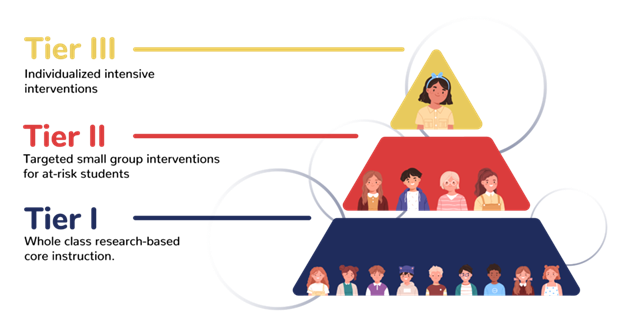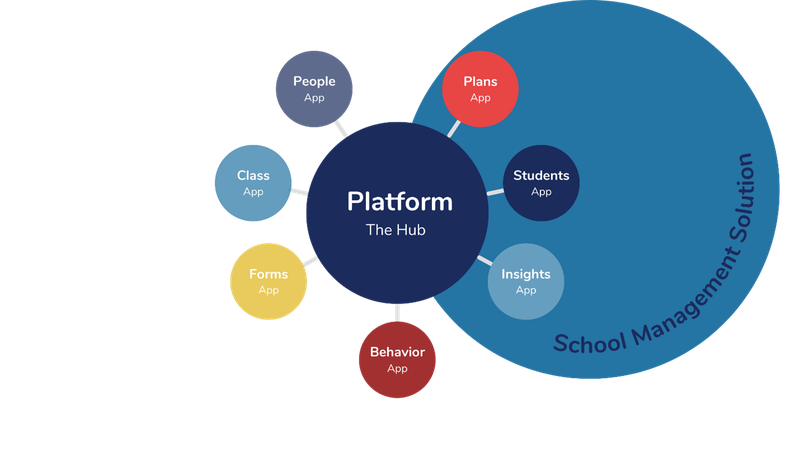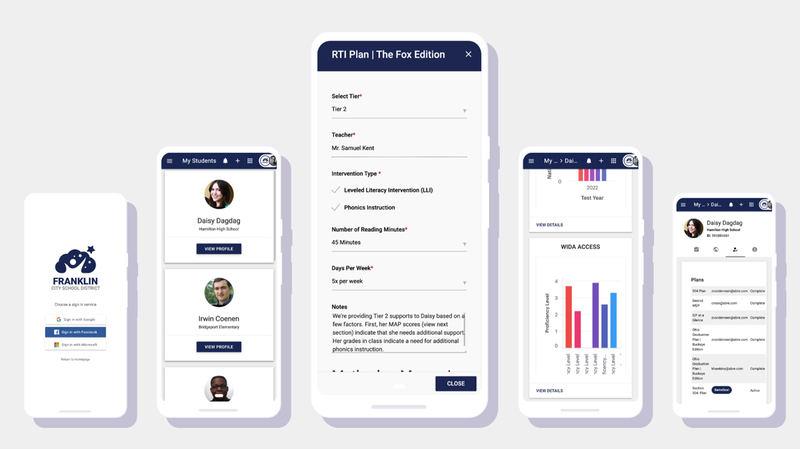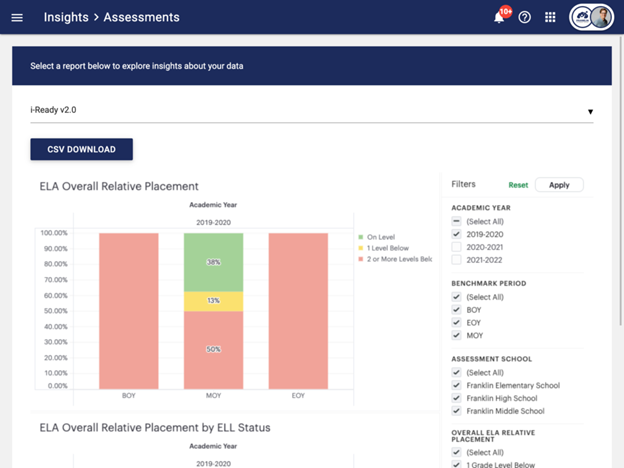Multi-Tiered Systems of Support (MTSS) has become an incredibly effective framework for increasing student success. We’re big fans of practical methods for supporting students, and MTSS is a valuable framework that delivers results.
At its heart, MTSS is a process that helps students grow and addresses two key areas for students – their academic performance and their behavior.
It’s probably not surprising to think that if you can support academics and behavior, you’ll have students thrive in school.
So, what are the best ways to help students?
Teachers constantly adjust their instruction and support for students based on what they see in the classroom. MTSS operationalizes this adjustment, dividing support into three tiers.

Tier 1: Universal Support
All students fall under Tier 1. It includes the core instruction and basic interventions involved with standard teaching. Ideally, you want the vast majority of students (75% - 90%) to only receive Tier 1 supports.
Tier 2: Small Groups
When Tier 1 isn’t enough, it’s time to group kids to receive Tier 2 interventions. This tier is an extra level of support, typically done in small groups, that feature targeted interventions. For example, a teacher may group students to receive additional reading instruction. Students in Tier 2 should only represent 10% - 25% of a teacher’s class load.
Tier 3: Individual Students
This tier is for students not responding to Tier 1 and Tier 2 supports. It features more intensive interventions and frequently involves outside supports. For example, a student struggling with classroom behavior issues may receive counseling services. Students in Tier 3 should represent less than 10% of a class.
Why the Percentages?
Aren’t the percentages…arbitrary? Could you not have a class where 30% qualify for Tier 3 interventions? Or might you have a class where Tier 1 supports are entirely sufficient?
In short, yes.
This is why MTSS is a pragmatic framework. Like most things in life, education has finite resources (teachers, time, money, etc.), and wisdom is learning how to use those finite resources in the best way possible. Given the limited resources schools face, the percentages are a good rule of thumb.
The Key Components of an MTSS Framework
Now that we’ve defined MTSS, let’s define the components of the framework. To get the most out of your MTSS framework, it should include six key components.
- Screening. Screening tools that assess students in the areas of behavior and academic performance.
- Student plans. A committed plan to address identified struggles.
- Strategies. The use of evidence-based instructional strategies to help students. No gut feelings, if you will.
- Monitoring. Monitor progress to know what is and isn’t working.
- Professional development for educators. Quality educator training is vital to MTSS implementation.
- Family involvement. Supportive family members are integral to the collaborative process.
Pulling all these components together into a coherent process takes effort. Done wrong, this can result in massive inefficiencies and more important, a misalignment between student needs and educator responses. Done well, students grow, teachers focus on teaching, and parents become part of the learning process.
Screening Students for Multi-Tiered Systems of Supports
Your school decided to embrace the MTSS framework for supporting students. The first stage in this process is screening. The critical question is, how do you know which students need additional support? You don’t want to go with gut feelings or anecdotes. You’ll want empirical data.
Ideally, you’d also like this data to be clear, easy to understand, and not require hours and hours to gather and crunch. We’re always looking for the “goldilocks” experience. Not too easy, not too hard, but just right.
Just right delivers results.
Your first decision: Are you screening for behavior or academics? Of course, the two are frequently related. But when it comes to future interventions, defining your core inquiry is helpful.
Questions to Consider with Screening
- What tools are you going to use for screening?
- How easy is it for your MTSS team to access these tools?
- Once tools are identified, what criteria are you using to determine if a student requires the MTSS framework?
- Once a student is selected, how does the school kick off the next stage of the framework?
Once that is decided, you’ll need to determine what data sources you will use for screening. For example, with behavior you may use:
- Number of times a student has been sent to the office
- Types of behaviors observed
- How often teachers make notes about the student in their classes
- School attendance
Likewise, for academics, you may want to use variables such as:
- State assessments
- Grades
- 3rd Party Assessments (MAP, iReady, STAR, etc.)
- Common Summative Assessments
Beyond identifying the data sources, you’ll also want a sense of severity or a defined risk spectrum. Does one office incident trigger a Tier 2 intervention? Do ten? Remember the rough percentages you’re aiming for regarding Tier 2 and Tier 3 interventions.
Making It Easy
Let’s look at how you can quickly screen students. For example, we’re using a fictional school and logging into Abre, where we’re going to use two Abre Apps: The Insights App and the Students App.

Let’s start with the Insights App. Broadly speaking, Insights allow you to gain an understanding of data. What kind of data? Pretty much all data associated with schools. In this case, I’m going to the “MTSS” category to quickly find students who likely need to start the MTSS process.
Franklin has defined the following variables as necessary for an early warning system:
- Hours of attendance
- Office Behavior Incidents
- State Tests
- NWEA MAP
- And Social-Emotional Health
Note that these variables very much address the two areas of MTSS: Behavior and Academics.
Say I am the principal at Hamilton Elementary School. I want to know who I should include in the MTSS Process. I will go with all my students who fall under “Extreme Risk” and “Very High Risk”. I select my school and the risk categories and apply.
How to Quickly Find at Risk Students
Immediately I know which students to focus on based on my set criteria. If schools have defined the criteria for Tier 2 and Tier 3 interventions, I can even have that in the report.
Side Note: As a district leader, I can also understand my staff’s workload and the resources I’ll need. This is always helpful when making a case for hiring decisions.
Let’s Take a Closer Look
So now you have a list of students qualifying for interventions. But you’d like to learn a bit more about the individuals.
My one student who stands out is Daisy. She’s missed a lot of school, is a frequent flier for behavior incidents, and has state and MAP scores that scream “warning”.
I want to know more about Daisy – her complete picture. To do this, I jump into the Students App. I can gather information about all components supporting and shaping Daisy’s education. For example, I can view her schedule, 3rd party assessments, education plans, grades, social-emotional health, and behavior.

Keep in mind we’re in the Screening Stage of the MTSS Framework. Why should Daisy obtain tiered interventions? From her profile tab, I see she’s having attendance issues. I can see her results for all 3rd party assessments on her Assessment Tab. In this case, I’ve focused on the State Test and NWEA MAP. Finally, to get a sense of her behavior, I can do a deep dive into office and personal behavior incidents.
Let’s Make a Decision
So Daisy clearly needs some attention. Most schools at this point bring together an MTSS Team to decide to provide interventions.
The team gets together and makes the decision: Daisy needs tiered interventions. She needs two plans: A behavior intervention plan (BIP) and an RTI (response to intervention) plan.

When Should You do That Intervention?
The image above reflects a year over year of English Language Arts proficiency, with lots and lots of red. Red indicates that learners are two or more levels below grade level proficiency. As an education leader, this data is a call to action.
Quick decision: Add a one-hour block of intervention time every week.
And then we can consider the additional complexities: What type of intervention? How will these interventions be monitored? How will differentiation occur?
Before all that, a key question needs to be asked.
When should they offer the one-hour block?
Simple questions should be simple to answer. The answer is easy: They should offer the intervention block on the day of the week when most students attend school.
But finding that day is NOT simple. It frequently means calling up the person who runs school attendance, downloading data from the student information system, and then (likely) manipulating data in a spreadsheet.
Creating a Behavior Intervention Plan to Use in the MTSS Process
For a Behavior Intervention Plan, you may want:
- An overview of behavior that needs addressing
- A definition of the behaviors you want to see
- How will those behaviors be taught?
- What accommodations and interventions will be put in place
Once Created, It’s Time to Complete the Plan with the Identified Student
Recall that we’ve already identified students in need of Behavior Intervention. To add a behavior plan to a student:
- Navigate to Students Plans
- Search for your student
- Add the Behavior Intervention Plan
- Complete the Plan
When an educator suspects a student requires MTSS and the defined framework, a referral kicks the process into gear. You’ll need to create a referral form. A referral really should contain data that demonstrates what a teacher is using for basing the referral.
Once a referral is made, a decision needs to be made. Are the Tier 1 supports doing the job for the student? Or are higher tiers of support required?
Most schools use a decision-making group to determine the answer to these questions.
The group frequently invites family members and students into the process. Thoughts and ideas are captured on an agenda.
If the decision-making group does come to the conclusion that, yes, a student plan is required, they then move to the next milestone.
Technically, MTSS isn’t exactly an education plan. Rather, it’s a framework that uses a variety of education plans.
Professional Development
Learning is critical to teachers as well. Professional development helps deploy an MTSS framework with fidelity. A Professional Learning Solution should include:
- The creation of staff professional development plans.
- The tracking of growth against that plan (and can be used for license renewal).
- The ability to create and share professional learning courses.
Bringing Families into the Process
The experience should also be available to family members. This knowledge helps them with their involvement in their child’s learning.
With the MTSS, family access helps with:
- Viewing any education plans for their student
- Viewing the data used for monitoring growth (for example: MAP scores)
- Viewing behavior over time
Monitoring growth is an essential part of the MTSS process. You can modify a Behavior Intervention Plan to record “growth periods” that record if and when growth occurs.
About the author

Zach Vander Veen has worn many hats in education, including history teacher, technology coach, administrator, and director of technology. He loves learning, teaching, traveling and seeking adventures with his family. Currently, Zach is the co-founder and Senior VP of Innovation and Outcomes at Abre.io, an education management platform.










